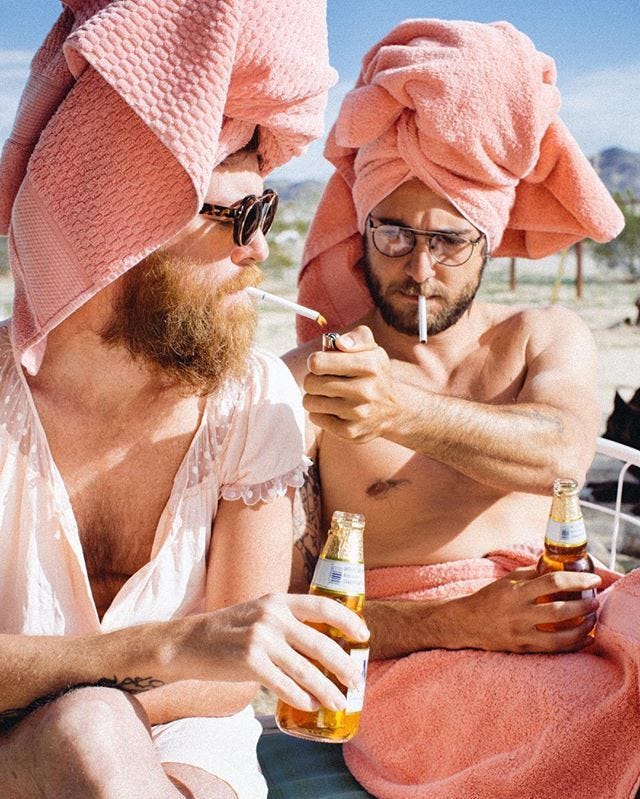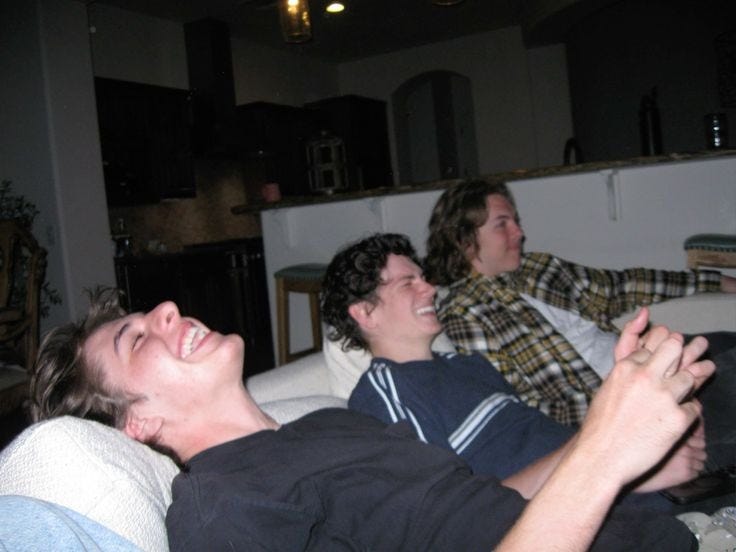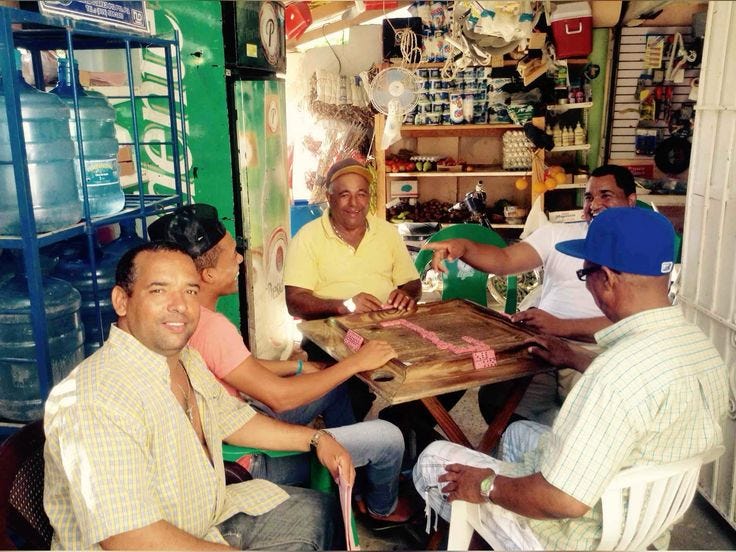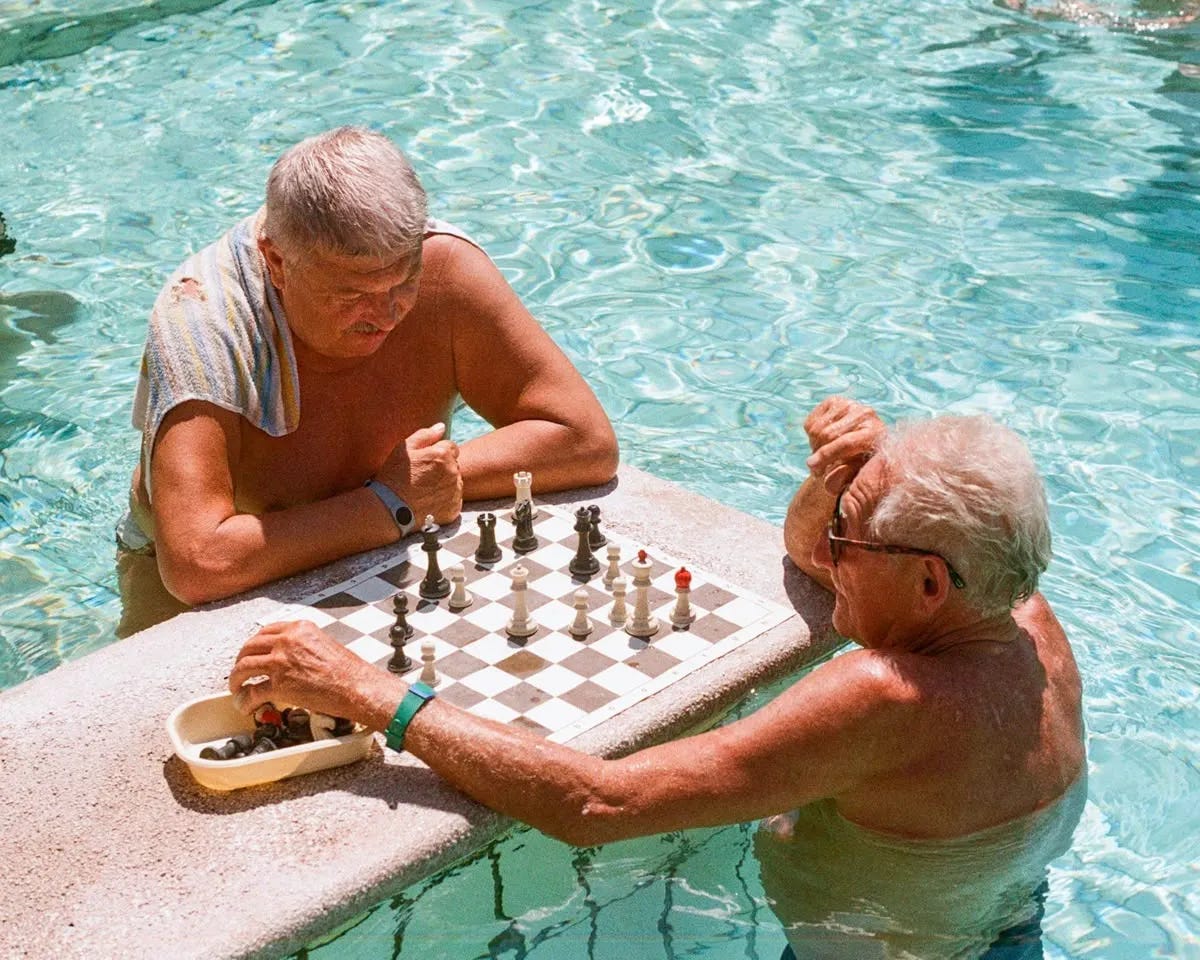Do Men's Groups Help Men?
Men’s groups are springing up like poppies. CNN's Harmeet Kaur and I talk through the rise of men's groups as a space that offers men a new social contract around how to be together.
From EVRYMAN to Men’s Sheds, Men’s Circle to Mankind Project, Junto to Manifest - to informal groups sprouting throughout North America, Western Europe and Australia - more men are seeking organized spaces to work on themselves in community with other men. Or at the very least, more men in rich countries are joining spaces where they go beyond stereotypes of how men “should” relate.
I spoke to Harmeet Kaur at CNN about how men’s commonly experienced longing for a different type of substance in their relationships with other men are being explored in spaces sometimes called men’s circles or men’s groups. You can see the piece that came out of this conversation here. This behind the scenes conversation covers:
What are men’s groups? Are they similar to each other? Why are they on the rise?
What do researchers know about men’s circles? How effective are they, and effective at achieving what exactly?
What are the promises and pitfalls of men’s groups? Do they rely on male gender stereotypes, and is that bad?
How connected are modern men’s groups to the mythopoetic movement of the 80s and 90s?
So…should I join one? Should my husband/boyfriend/brother/father/uncle/son/friend join one?
Harmeet: Can you tell me how you first encountered men’s groups?
Angelica: I became aware of the rise of men’s groups while interviewing men for my forthcoming book Men Without Men. Every tenth or so interview, men’s groups continued to come up, either in the form of a man who had been helped by a men’s group, or one who was interested in joining.
Those who had been a part of one said the groups had supported their mental health and gave them the sense of community they desired but didn’t know how to access elsewhere. When Pasco Ashton, founder of the UK group Men’s Circle, told me about the reasons men in his group signed up to join, the number one reason participants chose on a poll was “social connection.”
A participant in my research suggested that I watch the 2017 documentary The Work, a film about group therapy between incarcerated and non-incarcerated men in California. It shaped my sense of what’s possible when men commune with an openness to relate beyond the often activity-centered, sometimes homophobic, competitive, nearly exclusively humor-based, or even violent ways many men have been raised to relate to one another or have seen presented in the media. Contrary to the long history of men’s spaces as one of consolidating male power and concretizing women’s exclusion from public life, contemporary men’s groups are, for the most part, questioning the emotional fallout of being raised under patriarchy. Men’s groups brand themselves as spaces apart from stereotypical male relating: in most, you’ll find men sitting in a circle or facing each other, speaking in a way that the pub or the working men’s club tends not to facilitate. With the right facilitator who has a solid training in an anti-patriarchal framework, this has transformative healing power, and many men speak to this. The paradox, though, is that many of these groups still traffic in new or recycled directives about what “real men” should be, but we’ll get to that later.
Harmeet: How do we define them?
Angelica: They vary massively. In this case we’re not simply talking about men any time they join a group or activity. Neither are we discussing Men’s Rights Activist groups. We’re also not talking about groups that are formally part of the mental healthcare system, such as men who have sought out group therapy under the supervision of a licensed professional.
What I’m talking about is the rise of a discrete form of male space organised around emotional openness, self-reflection, and community. Some look like group therapy, with check-ins and structured exercises borrowed from clinical psychology or corporate coaching. In the best case scenario, these are led by a trained facilitator. Others lean toward ritual, invoking common mythology and historic male archetypes, a legacy of the mythopoetic men’s movement of the ’80s and ’90s — I’ll talk more about that movement later, too. There are activity-based groups such as “men’s sheds,” offering informal, tool-in-hand camaraderie to counter social isolation aimed at getting older men out of the home and into each other’s presence. Another piece of the men’s group pie happens through weekend retreats built around initiation-like experiences, sometimes involving guided psychedelic journeys. One group I’ve worked with called “The Confident Man Ranch Retreat” brings men together to take a quantum leap in their relational skills through working with horses. Others blend breathwork, drumming, and primal or “authentic” movement (a less scary way of saying dancing); and hundreds of smaller circles take place in living rooms, yoga studios, and forests. Most men’s groups tilt in at least one of these directions, but their center of gravity hovers around a general drive for self-improvement, emotional wellbeing, and social connection.
Harmeet: Are these groups on the rise?
Angelica: No one is formally documenting the rise of men’s groups. That’s either because no one’s gotten around to it or that defining what counts as one is a tricky. Anecdotally, though, I’ve watched the number of groups in my awareness explode - I’m of course the kind of person who is extra aware of these things, but even for me, their rise is pretty notable. I see advertisements for them commonly in East London where I live - something I can’t remember even a few years ago. Flyers are increasingly common sights around New York, Los Angeles, Washington DC, San Francisco, London, and Berlin. Again, this is without the data to support it, because we don’t have that yet, but it seems men’s groups of this nature (those aimed at relational skills and emotional evolution of some flavor) are more common in areas dense with affluent, younger, politically progressive people. Many men pay for their men’s group memberships, but which types of men are the most likely to have the discretionary income and time to do so? That tells us that the first wave of men’s group participants are likely to be an affluent sector of society who are open new ideas about masculinity - but we shouldn’t paint too broad a brush. Pasco Ashton’s group, Men’s Circle, been particularly successful at marketing to an age-diverse audience outside of major cities and to new fathers - groups that are sometimes hard to reach and face heightened pressures not to share emotional struggles with other men.
Harmeet: I’m curious about what can be learned from men who have participated in these groups
Angelica: For most men who were part of one in my research, looking another man in the eye for more than a few seconds was terrifying before taking the leap together, as a group. I think of that Liz Plank quote: “Expecting men to be emotionally intelligent in their relationships is like expecting people to know how to do a butterfly backstroke when they’ve been instructed to never get wet.” Hearing from men after or during their men’s group experience, which was often spurred by their wives or girlfriends (something the psychologist Terry Real calls “wife-mandated referrals”), or a significant event like a divorce or breakup, was the first time in a long time that they’ve gotten into the metaphorical “pool” with other men. They almost always liked it, despite how scary or awkward it was initially, and that surprised them.
I can only speak to the stories of men who have gone to groups that explicitly value expressing the emotions that men are generally socialised to suppress. Navid, a 44-year-old participant in my research, said this about life before joining a men’s group: “I didn’t know how to have intimacy with anyone I didn’t want to have sex with.” Navid was one of many people who said that joining a group was an enormous step towards becoming comfortable speaking to male friends about emotions typically considered to be tender or weak. Through a round about pathway, these groups also had a positive effect, men said, on their romantic partnerships with women. Learning intimacy in one context often translates to another.
Yet of all the things men may receive from these groups, one stands out the most. Steve Horsmon, one of the leaders of the Confident Man Ranch Retreat said something unforgettable about what men derive from the experience: “they don’t get what they want,” he said “but they get what they need.”
By that he meant that men often didn’t get their wives or girlfriends or jobs back just by simply working on their listening skills and interpersonal confidence, nor did they find a complete life transformation waiting on the other side of the retreat, but they made friendships based on a type of substance that can be hard to cultivate in the “real” world. Sometimes those friendships were with men twice their age. Men in my research spoke with warmth and achievement about having an ongoing an text message thread with the members of their men’s group. Community without having to perform a dominant, aggressive type of masculinity, or simply having someone to speak to outside of work or the home with the built in agreement of not being judged for weakness, is often the crux of the draw and the benefit. Men’s groups attempt to provide a new social contract for men to be with other men.
Harmeet: I’m also curious about the extent to which men’s circles still rely on stereotypes about who men should be. Have you come across any notable examples of this? If so, what are your thoughts on this contradiction? Do you still see these circles as a net positive in those instances?
Angelica: You’re right that many men’s groups rely on old or unhelpful ideas about who men should be. Some of these groups work by saying that a “real" man is emotionally vulnerable and a provider not just through finances, but through emotional support to others. Others frame the emotional work that men do within them as a type of fitness or strength. EVRYMAN has embraced its framing as “crossfit for your emotions.” It gets men in the door without stigma, but it relies on the very ideas that these men are trying to challenge.
When men’s groups use these tactics to attract members, they still imbue men with value and status in other men’s minds, solely on whether they are doing masculinity right—and often make statements about what makes a “real” man. This is a problem no matter what qualities or behaviors we put on the list of what a man should be, even if those are positive things. Adding additional directives to masculinity like “emotional crossfit” is an age-old exercise in telling men how to perform gender, adding to the list of ways they must be “fit” or else. That critique doesn’t mean throwing the baby out with the bathwater: adding relational intelligence and deeper community to the laundry list of directives for how to be a man does have lot of potential upsides - but I see a huge cost, too.
That’s not to mention that many of these groups are very unclear in how their leadership was trained and whether they have the capacity to handle the emotional responsibility of group work. There’s also been some concern—and this is not exclusive to men’s groups but is more endemic to the unregulated wellness space—that they operate on a pyramid scheme model. Participants are encouraged to become facilitators, facilitators are encouraged to bring in participants, and money flows in the direction of a few leaders or founders at the top of the business. I’m not one to knock a group trying to do good, though, so I’ll save that discussion for another day.
Harmeet: To that end, what do we know about whether these groups can actually live up to their promises?
Angelica: We don’t know much yet. Research hasn’t caught up to the pace at which these groups are popping up, and there are factors that make it tough to assess them empirically. They are substantively different from each other not just in content, tone, and activities on-offer, but because they are interventions or experiences of wildly different durations. Some men’s work is done in a weekend retreat, other groups are conducted online across a period of six weeks or longer. Some have group chats that are active for months and years after the initial group work.
These differences mean there’s no standard way of assessing the efficacy of men’s groups. It’s also unclear what to measure: we’d expect that participating in these groups would enhance feelings of social connectedness, which shares robust relationships with mental and physical health. But there’s much more we could look at, such as if men feel their social and emotional skills have been strengthened. Researchers have talked about conducting surveys with the friends and family members of men’s groups to see if the changes men experience translate into the emotional atmosphere of their “regular” life. Some of the initial data we have on these contemporary men’s groups focus on men’s relationship with masculinity. A 2024 study assessing the EVRYMAN group reports that participants’ “masculinity attitudes become malleable when sharing vulnerability is met with the promise of connection, rather than the backlash.” That’s hopeful, but we need a lot more data.
Harmeet: In my research, I found that some men’s work organizations (Mankind Project, Sacred Sons, Junto) have their roots in the mythopoetic men’s movement of the ‘80s and ‘90s. Do you see elements of this movement in men’s circles today? If not, how have they evolved past that?
Angelica: There are threads of the mythopoetic men’s movement of the 80’s and 90’s within the modern men’s circle trend, without a doubt. One of the big similarities between some men’s circles and the mythopoetic movement is the belief that men’s initiation rituals are critical parts of men’s development that have been lost, cast aside, or forgotten. Whereas men’s circles don’t usually go so far to say that society has lost male rights of passage that guide men through critical gauntlets of emotional and spiritual development, they are vaguely referential of these traditions and the particular sacred or structural “drama” of them.
Most men’s groups today use a very different lexicon than the mythopoetic movement, which can destabilize the idea that men necessarily need highly specific archetypes (i.e., the wounded warrior or the lost boy) or rituals to become self-possessed, emotionally whole adults. What’s shared between the mythopoetic men’s movement and men’s circles is the notion that rituals are important to many men’s lives and their emotional maturation, and I agree that rituals can have an important role for people of any gender, but I’m interested in how we can think about them in new ways. What if the rituals men and boys were part of involved learning the ins and outs of intimacy, not just strength and responsibility? What if we emphasized rituals of strength, responsibility, and protection in the raising of girls too?
Traditions that welcome people to their gender by giving them specific directives are always going to be somewhat (or even enormously) fraught. When we get to the heart of groups that bring men and boys together to “become men,” we often still see limited views of maleness that don’t let all men in the door, especially those that are not allured by tying their manhood to how strong or protective or emotionally “fit” they are. I know how powerful men’s communities can be, but if a group is claiming to be for men but is only for a certain kind of man, is it really for men?
Harmeet: So do you think these groups are a net positive or net negative? Should people be joining them?
Angelica: I believe these groups are a net positive, and the majority of scholars in the field tend to agree on this. There will always be exceptions. Still, they are among the first line of solutions for scalable interventions combatting men’s social isolation, which we know improves the lives of women and children, too. My hesitation around a more enthusiastic endorsement comes from knowing that some of these groups package community and brotherhood within a strict view of manhood that is ultimately reductive (such as saying that a “real” man provides, not just financially but emotionally). As bell hooks says, until we value men for being people—literally JUST for being—and not valuable based on what they do or provide for us, we won’t be liberated from constraining ideas about gender. Not everyone agrees this is the right approach though—see a panel we did at Stanford University for a deeper discussion on whether masculine norms are important to keep in tact. Not all my colleagues agreed with me.
It still stands that the more men create community involving the competencies that deep intimacy involves, and are doing so with other men in the presence of an intentional facilitator, more men might question how useful masculinity is as a governing system for their lives and behavior all together. Men’s groups can make that interrogation more widespread and gently introduced. And along the way, the friendships they take from them, as well as the strengthened relational skills, benefit everyone in men’s lives, not just men.




